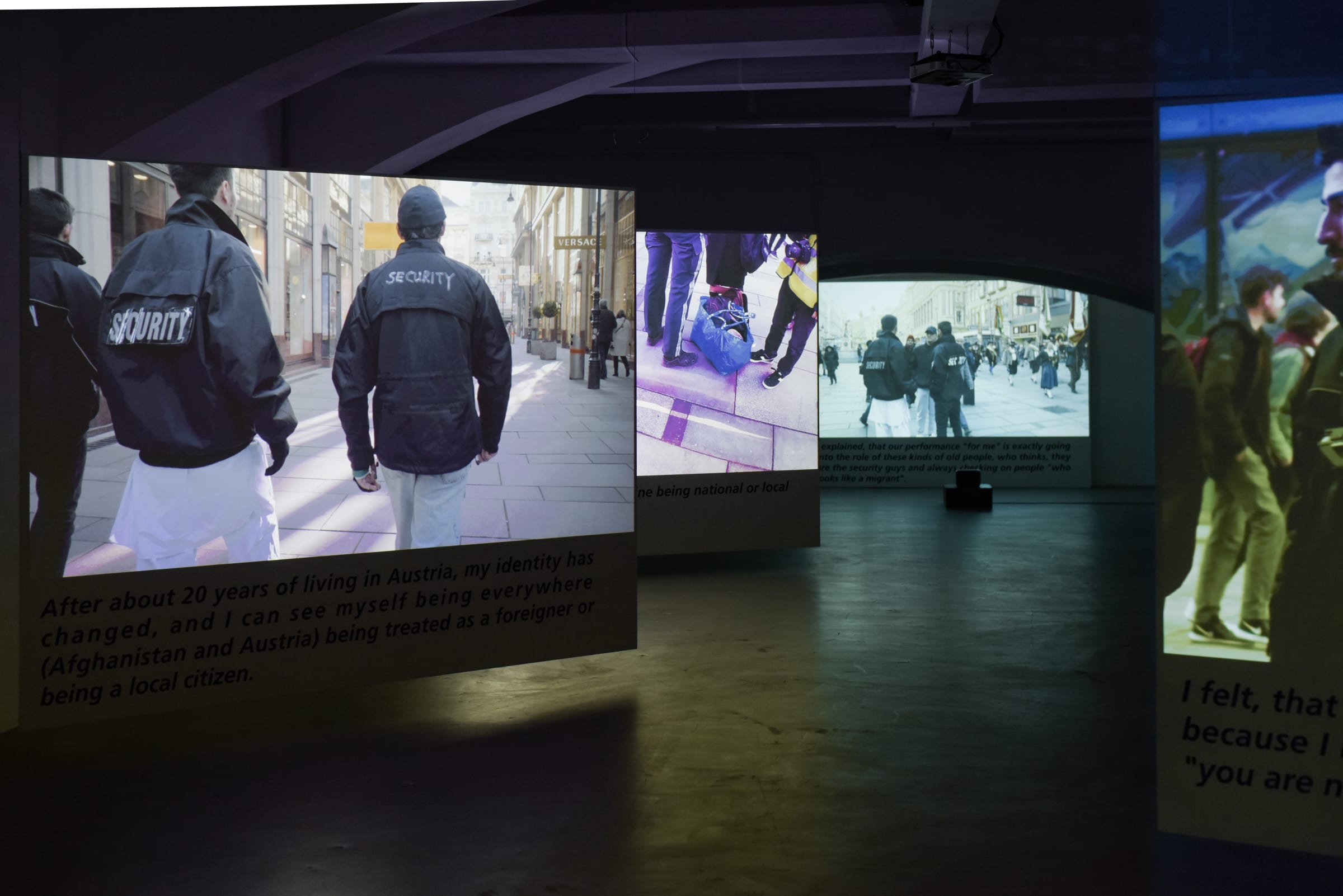06 May 2020 One might be forgiven for mistaking the large black metal bin outside the entrance of Das Weisse Haus as nothing more than another on-street clothing donation bin. However, its lettering betrays a more subversive purpose: “Worried about your Nazi grandfather’s hat in the attic? Unsure what to do about it? Too ashamed to sell it, too emotional to burn it? I have a solution!”

Yoshinori Niwa, Immigrants are Guarding This Country, installation view, Das Weisse Haus, Vienna, 2020
Withdrawing Adolf Hitler from a Private Space (2018)—a provocative project involving the collection and incineration of items from the Nazi period— was part of Japanese artist Yoshinori Niwa’s first solo exhibition in Austria, given the equally provocative title: “AB 1. OKTOBER 2017: VERBOT DER GESICHTSVERHÜLLUNG IN ÖSTERREICH” (“FROM 1 OCTOBER 2017: FACE COVER BAN IN AUSTRIA”).
Niwa repurposed the name of the controversial Austrian law, known colloquially as the “burqa ban” (in practice only burqas and niqabs are banned, but the law carries a neutral name in order to sidestep accusations of targeting Muslims), in an effort to probe the mechanisms through which cultural identity emerges not merely through a set of objects (such as Nazi-era memorabilia), but rather as a result of narratives or discourses that imbue objects with meaning.
Yet, as Niwa demonstrates in two new pieces, a totalizing national language and rhetoric of belonging can just as easily deracinate and exclude. What does one do, for example, when one does not speak the local language and can neither understand nor engage with a nation’s narrative? In Manifesting a Newspaper (2019), the artist responds by imaginatively rewriting that narrative in a series of drawings on 24 individually framed Austrian newspaper pages in which red kanji is superimposed on propagandistic text. The hybrid texts resulting from this dialectical process of de- and recontextualization not only hijack the narrative (non-Japanese readers are now at a loss), but also underscore how meaning and history are heterogeneous, performative processes.
Nowhere is this more evident than in Immigrants Are Guarding This Country (2020). In a darkened room on the gallery’s periphery, largescale video screens show clips from a public performance involving former asylumseekers living in Austria. Clad in black jackets emblazoned with the word “SECURITY,” the three men were filmed walking around Vienna’s central square, Stephansplatz, questioning passersby about their activities or offering assistance before being stopped and questioned themselves by the local police. An inversion of traditional gatekeeping roles, the work highlights the extent to which politicized notions of inclusion/exclusion are often marked by forms of xenophobia based on language, skin color, and religion. With the recent appointment of Alma Zadić, the daughter of Bosnian refugees, as Austria’s first minister with a migrant background, the piece is perhaps Niwa’s most topical. Indeed, Niwa’s virtual lack of coverage by the Austrian media (as well as the vitriol aimed at Zadić) speaks to the dangers of exercising political power and cultural authority within narrowly prescribed boundaries that limit and exclude based on perceived (and often misconceived) differences.
The second half of the show gathered a number of older performance videos that engage with denuclearization in Japan (Walk in the Opposite Direction of a Demonstration Parade, 2011), the politics of global waste (Going to San Francisco to Dispose of My Garbage, 2006), and post-communist Europe (Transferring Puddle A to Puddle B, 2004). Channeling Jiří Kovanda’s 1977 performance I carry some water from the river in my cupped hands and release it a few meters downriver... and scholar Astrida Neimanis’s intersectional theories of bodies and water, the latter video sees Niwa transferring water from one puddle in East Berlin to a puddle in West Berlin across a nonexistent border with his mouth. Such transgressive “border crossings,” Niwa seems to suggest, carry the potential to destabilize culturally embedded taxonomies of differentiation.
Cultural theorist Homi Bhabha has written that there is “a particular ambivalence that haunts the idea of the nation, in the language of those who write of it and the lives of those who live it.” In a similar vein, Niwa’s art forsakes the mythopoetic certainties of the nation-space, offering instead a highly suggestive ambivalence rooted not in negation but rather negotiation.

